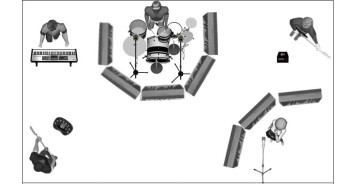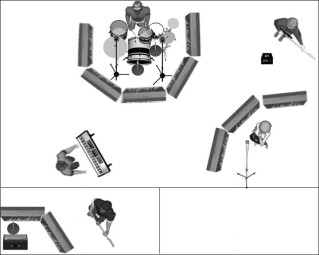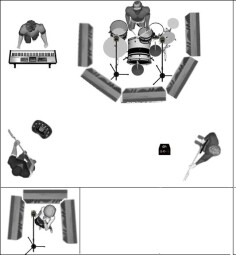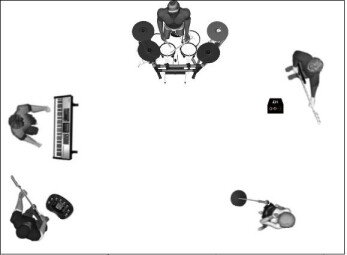So, you’ve got a band, you’ve got some recording gear, and you’re ready to start cutting your album in your home studio. If you’re recording with a drummer and you want to do a “live” basic-tracking session with the instruments playing together (rather than a layered overdubbing approach), you’re going to have some decisions to make in order to keep the drums from leaking into the other tracks, and vice versa.
Don’t let it bleed
If you’re not familiar with the terms, “bleed” and “leakage” both describe when one instrument or vocal gets onto another’s track through its microphone (or microphones) during recording. Significant bleed can cause a lot of problems during mixdown. Commercial studios have iso booths, separate drum rooms, and lots of sound absorbent baffling, which makes it relatively easy to avoid leakage. Home-recording musicians don’t typically have those kind of facilities, so we have to improvise a bit. Here are some solutions to avoid bleed when recording live basic tracks with a drummer.
Direct methods
One way to go, is to record the other instruments — electric guitar, bass or keyboards — direct so that there’s no problem with drums leaking into amp microphones. A bass or keyboard going direct is pretty standard, and you can always re-amp later if you want to change the sound. Electric guitars, on the other hand, usually need an amp to get a good sound. So what to do?
|
This shows a one-room setup where bass and keys go direct, guitar goes direct through an amp modeler, and reference vocals are sung as quietly as possible to avoid bleeding into the drum mics.
|
You have a couple of options. The guitarist could record through outboard amp modeling processor like a Line 6 POD, assuming he or she can find a good sound that’s appropriate for the music. Alternatively, you could just use the guitar-through-modeler setup to record the guitar as a reference track only, and the guitarist could overdub a final track later. You could also use a computer-based amp modeler to create the guitar’s reference sound, but unless you have a very low-latency setup, the delay might make it difficult for the guitarist to totally lock in.
Under the door
Another option is put the guitar amp in another room, or in a closet off the main room and mic it. If you have the space, you can plug a couple of mic cables together and run them under the door of one room into another room, and either have the guitarist record from in there — in which case you’d have to use a headphone extension as well — or run a long guitar cable so the guitarist can stay in the room with everyone else.
|
Putting the guitar amp into another room can greatly reduce leakage.
|
In that scenario, you’ll probably still have some bleed from sound coming through the walls, but if you put some blankets, pillows or other baffling around the amp (being careful not to create a fire hazard with hot tube amps), and keep the amp’s volume low enough, you should be able to get a guitar track recorded with minimal drum leakage, and keep any guitar sound get into the drum mics.
A lot will depend on the physical space, and thickness of the walls in your house or apartment. If you can get your hands on a cable snake, like those used in PA systems to run from the stage to the mixing board, you could run it to a room on the other side of the house or apartment (or even better on another floor on the other side of the house). In that case, you’d have to station the musician in that other room.
If you have a snake, you could even put the drummer in another far away room, and the rest of the band in the room with the recording setup, or even separate into three different rooms.
Some musicians may balk at recording separate from the rest of the band, but it’s not that hard to adapt. You’ll still be able to communicate via the live mics in the drum room and the mic on the guitar amp.
Reference is key
|
Here, the vocalist is setup in the other room, the bass and keys are going direct, and the guitar is going direct through a modeler.
|
Another issue is reference vocals. Many musicians have trouble keeping their place in a song without hearing the vocals. The problem is, if you have a vocalist in the room with the drummer, then those reference vocals will bleed into the drum mics. Either you can put the singer in a different room (running mic cables and a headphone extension), or have him or her very quietly sing or speak the vocals in the same room as the drums and have the vocal mic gain turned up extra high in the headphone mix so the others can hear.
You can temporarily hang curtains or moving blankets, or other absorbent materials around the kit to help reduce its sonic footprint. It doesn’t matter if the drums get in the vocal mic, since it’s just a reference that will be redone as an overdub. What you don’t want is vocals getting in the drum mics.
If you have an acoustic guitar or other acoustic instrument, you should probably just plan on recording it as an overdub. If the acoustic part is needed as reference for the musicians during tracking, use a DI’ed electric to play the part instead, and then record the final later. I’d avoid using an acoustic guitar in the room with the drums because it might leak into the drum mics.
Going electronic
One way to avoid most of these issues would be to use an electronic drum kit. Then you wouldn’t have to worry about the drums bleeding into other mics, which would solve a lot of the leakage problems. Of course, this will only work if your drummer has, or has access to an electronic kit, and is comfortable recording with it.
|
With the drummer using an electronic kit, and all the other instruments going direct, you’ll eliminate leakage, but could sacrifice feel and sound.
|
Advanced preparation
I would advise planning your setup in advance, and thinking through all the issues regarding leakage. Figure out what kind of setup you want to use, and if you have the gear to make it work. Between everyone in the band, you’re likely to be able to come up with what you need. Happy recording!




